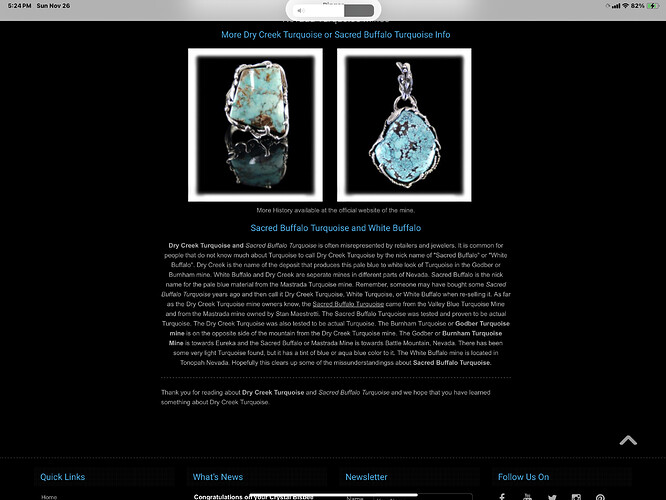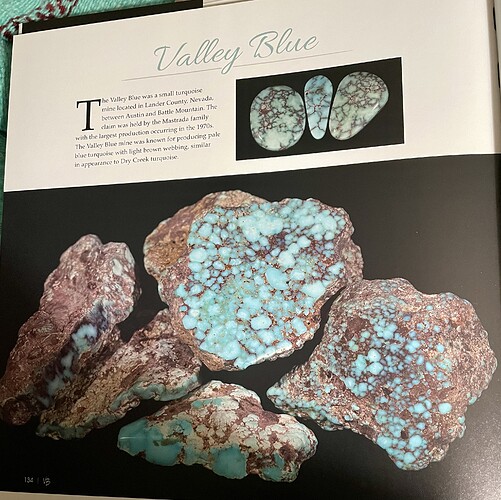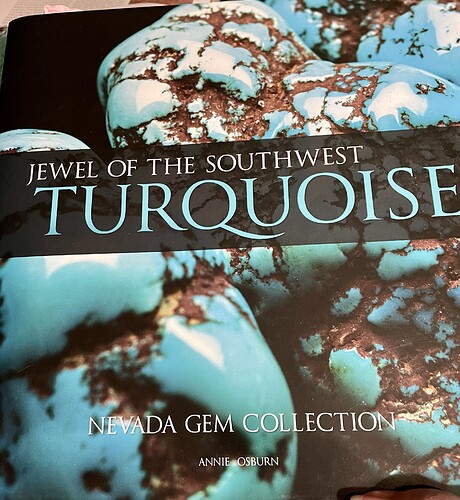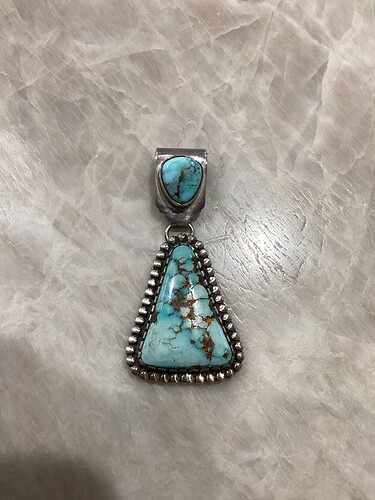The stones are absolutely beautiful- love love the big stone too: )
I couldn’t figure out what you meant it first. That is my cuff with a giant hunk of Valley blue turquoise by Eugene Martinez
Oh yes…the AWESOME cuff (not that the Squash blossom isn’t awesome!).
Well, here we are two years later, and I have learned a lot more more about this squash blossom. The Turquoise actually came from a mine that is situated across from Godber Burnham. The mine was called Valley Blue (and probably other names also) and was owned by Stan Mastretti. I emailed the Godber Burnham mine and Bruce Woods confirmed that it was from there. Stan was a relative and Bruce worked there when he was younger. I found mention of it on Durango Silver and also in Annie Osburn’s book “TURQUOISE Jewel of the Southwest” I will attach pictures from both of these sources. I am still trying to find out more. I would love to know who the artist is, construction details and approximate date it was made.
I have been wrestling with this for a long time and have gotten completely opposing opinions. There is one guy who made a point of being a total a— and telling me it wasn’t even turquoise. Another fellow recognized it and told me he hadn’t seen the turquoise since the ‘70’s.
I emailed the Godber Burnam again and asked about an appraisal. They said they didn’t do appraisals and recommended a person for me to contact. I sent him a message with pictures and he didn’t message back—-he called me immediately. We talked for about 15 minutes and his opinion based on pictures and description was more than $6000 and that after a hands on inspection it would probably be worth a good bit more.
I feel like I’m swimming upstream. There are no comps that I can find. Any information will be appreciated. Thanks
@Islandmomma Your new post has drawn me to this thread for the 1st time. Your Dry Creek turquoise squash blosssom necklace & earrings are stunning!! Just Wow. I rarely see Dry Creek used in squash blosssom necklaces (maybe that’s just me). I’m going to be researching that MD hallmark now. Sure wish I could turn up some good news about it for you.
Yes, it’s a very unusual necklace. It really makes you feel like a queen! I would appreciate anything you can find out. Thanks for your help.
Spectacular squash blossom necklace @Islandmomma. And thanks for all the info on the mines. I also love Osburn’s book on Bob Brucia’s Nevada Gem Collection. Personally I’m not attracted to the more pale types of turquoise, but I do have one piece Dry Creek pendant. I purchased it directly from the artist (Teesyatoh Shepherd, Navajo) at Crazy Horse Memorial, South Dakota in the mid 1990’s. The small stone on the bale is natural Pilot Mountain and the larger cab is Dry Creek. The photo looks a bit darker than it actually is, but it has more color than a lot I’ve seen. After this discussion, it seems like there are other mines that can produce turquoise similar to true Dry Creek…interesting.
That’s a pretty pendant. I think they are only those two mines that have actually had turquoise that was that pale. The other white stuff that has been dug, has been white buffalo, which I believe is dolomite and another white that was found which tested out as alunite. I hope I am right on these names. I should’ve studied geology. Lol. I initially wasn’t into the white either until a late friend offered me some really nice Dry Creek. Then, several years later, someone else that I know, offered this necklace for sale, and when I had it in hand, I didn’t think it was the same as the dry creek I owned. That’s what led me on this crazy quest to find out what it was. When I first started digging, I believe that Durango silver still had some of it that they were saving to cab and set. I was told that they no longer have any.
It is quite scarce, especially the lighter shades like your squash blossom necklace
That’s what I’ve been thinking since I have yet to see another one like it. Do you have any idea what kind of value this turquoise might have per carat? I know you’re around good stones a lot
I know this thread is discussing the squash… but… dang! I’m still all about that cuff ![]()
I agree! It’s one heck of a cuff. The artist inscribed the back with his hallmark, Valley Blue and 243.9 carats. I’m not sure how he came up with such an unusual band but it balances that humongous chunk of turquoise perfectly. It doesn’t slide around at all.
“When I first started digging,…”
lol,literal or figurative,girl?
![]()
![]()
![]() you got me on that one. I was digging online and in books. In fact, I was just online a minute ago and was looking at Valley blue items just to see what was out there. I found some things listed on eBay that turned out to be Chaney’s Turquoise listings. There was a Valley Blue cuff by Derrick Gordon and in the description it talked about this “Dry Creek “.
you got me on that one. I was digging online and in books. In fact, I was just online a minute ago and was looking at Valley blue items just to see what was out there. I found some things listed on eBay that turned out to be Chaney’s Turquoise listings. There was a Valley Blue cuff by Derrick Gordon and in the description it talked about this “Dry Creek “.
Overall I’m like @Bmpdvm, and am not as fond of the very light turquoise (except that cuff ![]() ), but years and years ago I bought a very pale colored ring at the Eiteljorg when they had some pawn jewelry for sale. I knew it was Kingman (pawn tag from Tobe Turpen stated so), but once when I was in a good store in Sedona, one of the owners said “I think that’s Dry Creek,” which I had never heard of back then. But as I wore the ring a lot, it darkened quite a bit (it looks better now I think), so I believe it was just a not very hard natural stone that darkened. So I’m inclined to wonder if some stuff gets called Dry Creek by mistake for the same reason (I don’t mean yours, Islandmomma).
), but years and years ago I bought a very pale colored ring at the Eiteljorg when they had some pawn jewelry for sale. I knew it was Kingman (pawn tag from Tobe Turpen stated so), but once when I was in a good store in Sedona, one of the owners said “I think that’s Dry Creek,” which I had never heard of back then. But as I wore the ring a lot, it darkened quite a bit (it looks better now I think), so I believe it was just a not very hard natural stone that darkened. So I’m inclined to wonder if some stuff gets called Dry Creek by mistake for the same reason (I don’t mean yours, Islandmomma).
That really might be true. I do know that the valley blue cuff does not appear to be nearly as hard or shiny as the necklace. And I have read somewhere that a lot of the valley blue was not super hard. So it would not surprise me at all, to know that some real light stuff eventually darkened with time. I do not expect that to happen with my necklace, because it is appears to have a very high silica content. I’m glad your ring darkened up and you enjoy it more.
@Islandmomma We’re in complete agreement, especially about that White Buffalo stuff! I’ve read that it doesn’t contain copper (which gives the blue color) so cannot be turquoise…but it lies in veins like turquoise and cuts and polishes like turquoise. I’m a purist and it is isn’t turquoise chemically, it’s not turquoise. Some call it Howlite or Magnisite, or whatever. I find it interesting that most turquoise mines produce some poor quality light colored chalky product that is too soft to cut and polish. However, if stabilized, can it be considered white turquoise? Confusing.
I understand completely how our tastes and appreciation for turquoise can change over the years…keeps it interesting! And look at the wonderful crazy quest it took you on!
I didn’t mean I thought the really light chalky stuff that you’re talking about could be officially called Dry Creek; I’m just wondering if people wrongly call it that, especially since someone with knowledge mistakenly thought my ring was Dry Creek. You can call anything whatever you want on Etsy and eBay apparently ![]()
Oh, how correct you are! I get on some of those posts and read the most outlandish stuff you can imagine. I wish you could just take a red marker and correct things like a proof reader. I definitely don’t know it all, but I know some of what they put up there is total malarkey! ![]()
![]()
![]()
Not to change the subject but I see the same with gold prices. The pundits keep saying gold prices will rise if the fed cuts interest rates. When the fed changes rates either way gold moves a couple dollars. But last time OPEC decreased production gold shot up about $40 per ounce. A few days ago Brazil announced an agreement with OPEC the same time OPEC cut production. And gold shot up about $70/ounce. They want us to believe the good ole USA is still the standard by which gold prices move. Unfortunately I think it is now OPEC. But perception is reality. Maybe I’ll be proved wrong.



